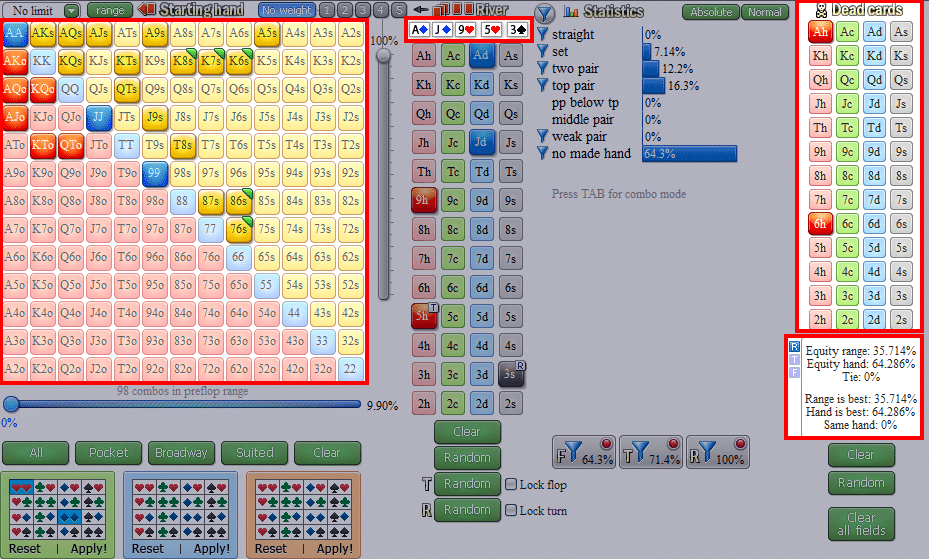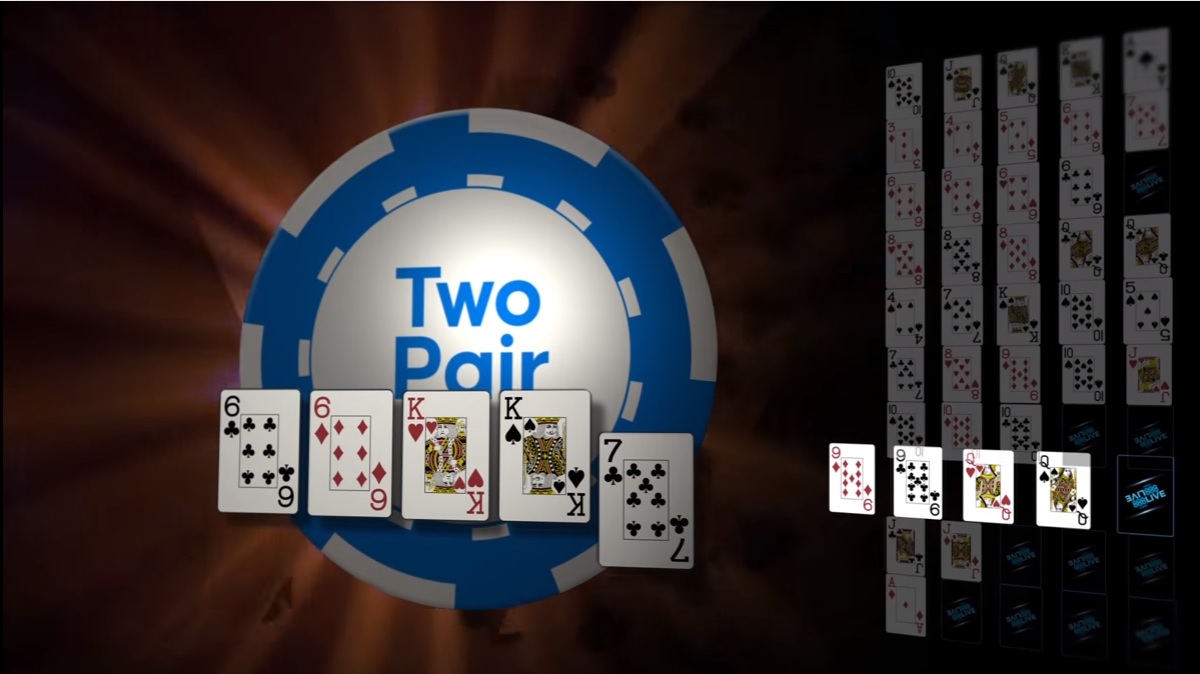Strength of poker hands texas holdem Each gambler has a chance to enjoy the slot games in a land-based casino or play slot online. No comments Posted in: Slots strength of poker hands texas holdem Playing Online Slot Machines Written by Blake.
- Texas Holdem Poker Hand Rankings
- Texas Holdem Hand Strength Chart
- Texas Holdem Poker Hands Printable
- Holdem Poker Hand Strength
In this lesson you’re going to learn the first and most important step about how to play poker by learning the all important poker hand rankings.
- A standard poker hand consists of five cards.
- Each poker hand is ranked in a set order.
- The higher the rank, the less chance statistically you have of getting it.
- The higher the rank of your hand the better, because two pairs always beats one pair, and a flush always beats a straight.
- When two or more players have a hand of the same rank, then there are more ways to determine the best hand.
Hopefully all these points will make perfect sense by the end of this lesson.
Poker Hands (from Best to Worst)
Texas Holdem Poker Hand Rankings
Be sure to pay close attention and memorize the poker hand rankings. Let’s start with the best possible hand in poker….
Royal Flush
A Royal flush consists of five cards of the same suit, in sequence from 10 through to Ace. Remember that all suits are equal in poker. If two or more players hold a royal flush (highly unlikely) then the pot is split, i.e. the players share the winnings.
Straight Flush
Five cards of the same suit, in sequence. This example shows a Jack high straight flush. If two or more players hold a straight flush then it is the highest that wins. For example, a Queen high straight flush beats a Jack high straight flush. You will notice that this is very similar to a Royal flush, and that’s because a Royal flush is in fact an ace high straight flush – but it’s given its very own ranking.

Four of a Kind
This hand contains four cards of the same rank/value. This example shows four 8’s, plus a 5 (remember that all poker hands must have five cards). If two or more players have four of a kind, then the highest value wins (e.g. four 9’s beats four 8’s). If two or more players share the same four of a kind, which can happen when using community cards (more on that later) then the winner is decided by the fifth card. So a player with four 8’s and a 6 would beat a player with four 8’s and a 5.
Full House

A full house contains three cards of the same rank, plus a pair. In our example you can see three 10’s and a pair of 7’s. The value of the three matching cards determines the strength of a full house. So three Jack’s with a pair of 7’s would beat our example hand. If players share the same three cards, which is possible when using community cards, the strength of the pair is then taken into account. So, three 10’s and a pair of 8’s would beat our example hand.
Flush
Five cards of the same suit in any order. Our example shows a Queen high flush. If two or more players have a flush then the player with the highest ranked card wins. If the players share the same high card then it’s determined by the value of the 2nd, 3rd, 4th, and 5th card respectively.
Straight
This hand contains five unsuited cards in sequence. Our example shows a King high straight. In the event of a tie, the best straight is determined by the highest ranked card. A straight consisting of 8, 9, 10, J, Q, would lose to our example hand. But a straight consisting of 10, J, Q, K, A, would win. Also note that an Ace can be used as the low card for a straight of A, 2, 3, 4, 5. This would lose to a straight of 2, 3, 4, 5, 6.

Three of a Kind
Three cards of the same rank, and two unrelated cards. Our example shows three 4’s. Three 5’s would beat our example hand, three 6’s would beat three 5’s, and so on. If players share the same three cards, then the value of the highest unrelated card would count and if necessary, the value of the second unrelated card. So, three 4’s with Jack, 8, would beat our example hand. As would three 4’s and 10, 9 (because 9 is higher than 8).
Two Pair
Two cards of matching rank, with another two cards of another rank, plus an additional card. In the event of a tie, the highest pair wins. If players share the same highest pair, then the value of the next pair wins. For example, a pair of Aces, and a pair of 6’s would beat our example hand, as would a pair of Kings and a pair of 7’s. If two or more players share the same two pair, then the value of the fifth card counts. So, a pair of Kings, a pair of 6’s, with a 4, would beat our example hand.
One Pair
A paired hand contains two cards of matching rank, plus three additional cards. The value of the pair determines who wins in the event of a tie. For example a pair of 10’s beats our example hand. If players share the same pair then the best hand is determined by the value of the highest additional card. If this is the same then it goes to the second card, and if necessary the third. So, a pair of 9’s with an Ace, 2, and 10, would beat our example hand. As would a pair of 9’s, King, 10, and a 3.
High Card
If a hand doesn’t fall into any of the above categories, then it is judged on the value of the highest ranked card among the five. In this example we have a hand which is Queen high. If players share the same highest card, then it goes to the value of the 2nd, 3rd, 4th, and even 5th card if necessary. A hand of Queen, 10, 9, 5, 4, would beat our example hand.
Community Cards
Texas Holdem Hand Strength Chart
As you already know, a poker hand consists of five cards. In many variations of poker, players receive or can choose from more than five cards. For example, in Texas Hold’em each player is dealt two private cards, but can also use the five community cards that are available for all the players to use. This makes a total of seven cards, but each player must choose their best five cards to make their best possible hand. Here’s an example:
In the above example, the best five cards among total of seven (two private cards and five community cards) would be combined to make a flush.
Conclusion
If you don’t fully understand the poker hand rankings then please read through the list again. It’s vital that you know which hand beats which. Of course, how good a poker hand is, is very dependent on which type of poker game you are playing and other factors such as the number of other players you are playing against. You will learn the true strength of a poker hand as you gain experience of playing the game.
We have created a printable poker hand rankings chart that you can use as a source of reference. Hopefully we’ve explained the poker hand rankings to you well enough whereby you don’t need this chart, but it still might be handy for some. The chart will load as a PDF (link opens in a new window) and you’ll need to have Adobe Acrobat installed on your computer to be able to view it.
Make sure that you memorize the poker hand rankings before moving onto the next lesson.
Related Lessons
By Tim Ryerson
Tim is from London, England and has been playing poker since the late 1990’s. He is the ‘Editor-in-Chief’ at Pokerology.com and is responsible for all the content on the website.
Related Lessons
Related Lessons
Effective Hand Strength (EHS) is a poker algorithm conceived by computer scientistsDarse Billings, Denis Papp, Jonathan Schaeffer and Duane Szafron that has been published for the first time in a research paper (1998). 'Opponent Modeling in Poker'(PDF). AAAI-98 Proceedings.
It has since then been considered as a reference in the realm of poker artificial intelligence and has been the basis of further research such as:
- 'Computer poker: a review'(PDF). Artificial Intelligence, Department of Computer Science, University of Auckland, New Zealand: 962–963. 2010.
- 'Application of AI in poker'(PDF). VU University Amsterdam Faculty of Sciences: 12–13. 2011.
- 'Advances in artificial intelligence – SBIA 2008 : 19th Brazilian Symposium on Artificial Intelligence, Salvador, Brazil, October 26–30, 2008 ; proceedings'. 2008: 85–86.Cite journal requires
|journal=(help)
Algorithm[edit]
The algorithm is a numerical approach to quantify the strength of a poker hand where its result expresses the strength of a particular hand in percentile (i.e. ranging from 0 to 1), compared to all other possible hands.The underlying assumption is that an Effective Hand Strength (EHS) is composed of the current Hand Strength (HS) and its potential to improve or deteriorate (PPOT and NPOT):
Texas Holdem Poker Hands Printable
where:
- is the Effective Hand Strength
- is the current Hand Strength (i.e. not taking into account potential to improve or deteriorate, depending on upcoming table cards
- is the Negative POTential (i.e. the probability that our current hand, if the strongest, deteriorates and becomes a losing hand)
- is the Positive POTential (i.e. the probability that our current hand, if losing, improves and becomes the winning hand)
Pseudocode[edit]
Hand Strength (HS) will enumerate all possible opponent hand cards and count the occurrences where our hand is strongest (+50% of the cases where we are tied):
In addition, EHS will consider the hand potential (i.e. its probabilities to improve or deteriorate):
Applicability[edit]
EHS is applicable to a wide variety of poker games such as Texas hold 'em poker, Omaha hold 'em poker, ...
Given the complexity of the algorithm, it can not be computed manually and has to be used in an Artificial Intelligence context.